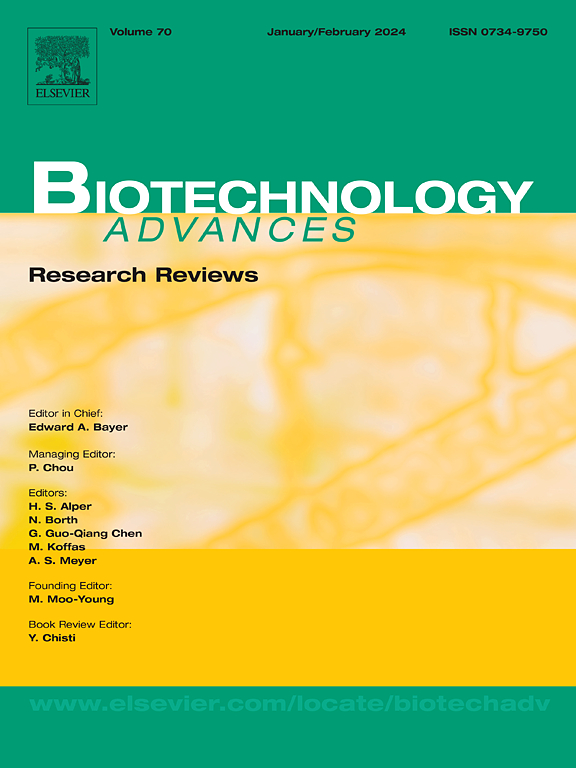Application of curcuminoids in inflammatory, neurodegenerative and aging conditions - Pharmacological potential and bioengineering approaches to improve efficiency
IF 12.1
1区 工程技术
Q1 BIOTECHNOLOGY & APPLIED MICROBIOLOGY
引用次数: 0
Abstract
Curcumin, a natural compound found in turmeric, has shown promise in treating brain-related diseases and conditions associated with aging. Curcumin has shown multiple anti-inflammatory and brain-protective effects, but its clinical use is limited by challenges like poor absorption, specificity and delivery to the right tissues.
A range of contemporary approaches at the intersection with bioengineering and systems biology are being explored to address these challenges. Data from preclinical and human studies highlight various neuroprotective actions of curcumin, including the inhibition of neuroinflammation, modulation of critical cellular signaling pathways, promotion of neurogenesis, and regulation of dopamine levels. However, curcumin's multifaceted effects - such as its impact on microRNAs and senescence markers - suggest novel therapeutic targets in neurodegeneration. Tetrahydrocurcumin, a primary metabolite of curcumin, also shows potential due to its presence in circulation and its anti-inflammatory properties, although further research is needed to elucidate its neuroprotective mechanisms.
Recent advancements in delivery systems, particularly brain-targeting nanocarriers like polymersomes, micelles, and liposomes, have shown promise in enhancing curcumin's bioavailability and therapeutic efficacy in animal models. Furthermore, the exploration of drug-laden scaffolds and dermal delivery may extend the pharmacological applications of curcumin. Studies reviewed here indicate that engineered dermal formulations and devices could serve as viable alternatives for neuroprotective treatments and to manage skin or musculoskeletal inflammation. This work highlights the need for carefully designed, long-term studies to better understand how curcumin and its bioactive metabolites work, their safety, and their effectiveness.
姜黄素在炎症、神经退行性疾病和衰老病症中的应用--药理潜力和提高效率的生物工程方法。
姜黄素是姜黄中发现的一种天然化合物,在治疗与大脑有关的疾病和与衰老有关的疾病方面显示出了希望。姜黄素已经显示出多种抗炎和脑保护作用,但它的临床应用受到一些挑战的限制,比如吸收能力差、特异性差、无法输送到正确的组织。正在探索生物工程和系统生物学交叉的一系列当代方法来应对这些挑战。来自临床前和人体研究的数据强调了姜黄素的各种神经保护作用,包括抑制神经炎症、调节关键细胞信号通路、促进神经发生和调节多巴胺水平。然而,姜黄素的多方面作用——比如它对microrna和衰老标志物的影响——为神经退行性疾病提供了新的治疗靶点。四氢姜黄素是姜黄素的主要代谢物,由于其存在于血液循环和抗炎特性,也显示出潜力,尽管需要进一步研究来阐明其神经保护机制。最近在传递系统方面的进展,特别是脑靶向纳米载体,如聚合体、胶束和脂质体,在提高姜黄素的生物利用度和动物模型的治疗效果方面显示出了希望。此外,探索载药支架和皮肤递送可能会扩大姜黄素的药理学应用。这里回顾的研究表明,工程皮肤配方和设备可以作为神经保护治疗和管理皮肤或肌肉骨骼炎症的可行替代方案。这项工作强调需要精心设计的长期研究,以更好地了解姜黄素及其生物活性代谢物是如何起作用的,它们的安全性和有效性。
本文章由计算机程序翻译,如有差异,请以英文原文为准。
求助全文
约1分钟内获得全文
求助全文
来源期刊

Biotechnology advances
工程技术-生物工程与应用微生物
CiteScore
25.50
自引率
2.50%
发文量
167
审稿时长
37 days
期刊介绍:
Biotechnology Advances is a comprehensive review journal that covers all aspects of the multidisciplinary field of biotechnology. The journal focuses on biotechnology principles and their applications in various industries, agriculture, medicine, environmental concerns, and regulatory issues. It publishes authoritative articles that highlight current developments and future trends in the field of biotechnology. The journal invites submissions of manuscripts that are relevant and appropriate. It targets a wide audience, including scientists, engineers, students, instructors, researchers, practitioners, managers, governments, and other stakeholders in the field. Additionally, special issues are published based on selected presentations from recent relevant conferences in collaboration with the organizations hosting those conferences.
 求助内容:
求助内容: 应助结果提醒方式:
应助结果提醒方式:


